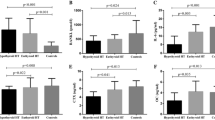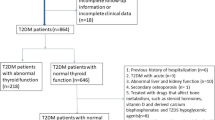Abstract
Hyperthyroidism is associated with increased bone turnover. Besides the hormones of calcium metabolism, locally produced factors are important in maintaining normal bone metabolism. Interleukin-6 (IL-6), in particular, has a major influence on bone turnover. In this study, serum IL-6 and tumor necrosis factor-alpha (TNF-α) levels, as well as bone turnover markers and relationships between them, were investigated in hyperthyroidism and hypothyroidism. A total of 20 female patients with hyperthyroidism, 15 with subclinical hyperthyroidism, 16 with hypothyroidism, and 15 with subclinical hypothyroidism constituted the patient groups. In all, 15 age-matched healthy female volunteers were recruited as controls. When compared with controls, serum TNF-a levels showed no significant difference in any of the patient groups (P<.05). In the groups with hyperthyroidism and subclinical hyperthyroidism, IL-6 levels were significantly higher compared with control group values (P< .05). Hyperthyroid patients showed higher levels of alkaline phosphatase (ALP) and osteocalcin, and a higher urinary deoxypyridinoline/creatinine ratio, compared with controls (P< .05). In subclinical hyperthyroidism, only ALP was found to be higher compared with control values. No significant correlations were made in any group between serum IL-6 or TNF-α level and bone turnover markers. Results suggest that serum IL-6 level and markers of bone turnover rate seem to be increased in hyperthyroidism. This finding may support the role of IL-6 in induction of bone turnover in hyperthyroid states.
Similar content being viewed by others
References
Dinarello CA, Moldawer LL.Proinflammatory and Anti-inflammatory Cytokines in Rheumatoid Arthritis. 2nd ed. Thousand Oaks, Calif: Amgen Inc.; 2000:3–23.
Ganong WF.Review of Medical Physiology. 20th ed. New York, NY: McGraw-Hill; 2001:307–321.
Siddiqi A, Burrin JM, Wood DF, Monson JP. Tri-iodothyronine regulates the production of interleukin-6 and interleukin-8 in human bone marrow stromal and osteoblast-like cells.J Endocrinol. 1998;157:453–461.
Siddiqi A, Monson JP, Wood DF, Besser GM, Burrin JM. Serum cytokines in thyrotoxicosis.J Clin Endocrinol Metab. 1999;84:435–439.
Lakatos P, Foldes J, Horvath C, et al. Serum interleukin-6 and bone metabolism in patients with thyroid function disorders.J Clin Endocrinol Metab. 1997;82:78–81.
Kurihara N, Bertolini D, Suda T, Akiyama Y, Roodman GD. IL-6 stimulates osteoclast-like multinucleated cell formation in long term human marrow cultures by inducing IL-1 release.J Immunol. 1990;144:4226–4230.
Ishimi Y, Miyaura C, Jin CH, et al. IL-6 is produced by osteoblasts and induces bone resorption.J Immunol. 1990;145:3297–3303.
Bartalena L, Brogioni S, Grasso L, et al. Interleukin-6: a marker of thyroid-destructive processes?J Clin Endocrinol Metab. 1994;79:1424–1427.
Bartalena L, Grasso L, Brogioni S, Aghini-Lombardi F, Braverman LE, Martino E. Serum interleukin-6 in amiodarone-induced thyrotoxicosis.J Clin Endocrinol Metab. 1994;78:423–427.
Fenkci S, Corapcioglu D, Erdogan G. The effects of thyrotoxicosis on serum IL-6 and bone turnover in premenopausal women.Turk J Endocrinol Metab. 2001;3:97–101.
Celik I, Akalin S, Erbas T. Serum levels of interleukin 6 and tumor necrosis factor-alpha in hyperthyroid patients before and after propylthiouracil treatment.Eur J Endocrinol. 1995; 132:668–672.
van der Poll T, Romijn JA, Wiersinga WM, Sauerwein HP. Tumor necrosis factor: a putative mediator of the sick euthyroid syndrome in man.J Clin Endocrinol Metab. 1990;71:1567–1572.
Pang XP, Hershman JM, Mirell CJ, Pekary AE. Impairment of hypothalamic-pituitary-thyroid function in rats treated with human recombinant tumor necrosis factor-alpha (cachectin).Endocrinology. 1989;125:767–784.
Ozawa M, Sato K, Han DC, Kawakami M, Tsushima T, Shizume K. Effects of tumor necrosis factor-alpha/cachectin on thyroid hormone metabolism in mice.Endocrinology. 1988;23:1461–1467.
Chopra IJ, Sakane S, Teco GN. A study of the serum concentration of tumor necrosis factor-alpha in thyroidal and non-thyroidal illnesses.J Clin Endocrinol Metab. 1991;72:1113–1116.
Author information
Authors and Affiliations
Rights and permissions
About this article
Cite this article
Sekeroglu, M.R., Altun, Z.B., Algün, E. et al. Serum cytokines and bone metabolism in patients with thyroid dysfunction. Adv Therapy 23, 475–480 (2006). https://doi.org/10.1007/BF02850169
Issue Date:
DOI: https://doi.org/10.1007/BF02850169




